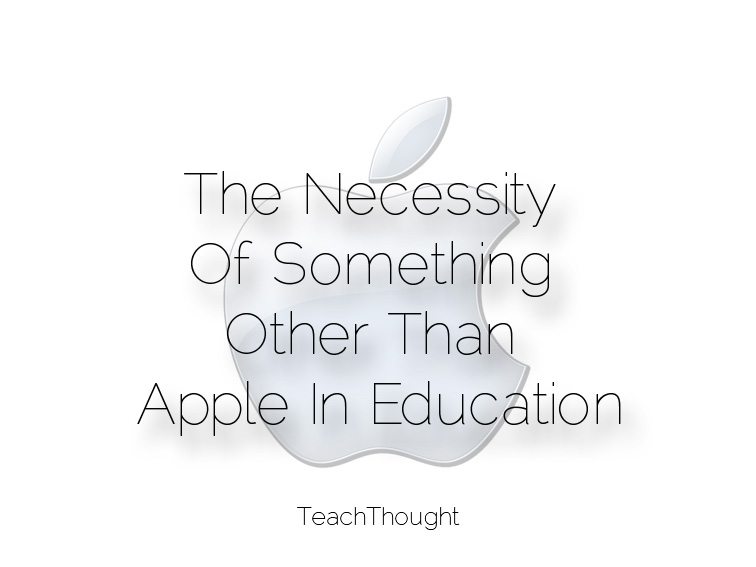 The Necessity Of Something Other Than Apple In Education
The Necessity Of Something Other Than Apple In Education
by Terry Heick
This isn’t an anti-Apple piece; it’s about symmetry.
The discussion about learning with tablets is a difficult one to push critically. Conversations here gradually trend toward apps, cost, equity, or even the consumption versus production argument. Rarely, however, do they extend fully to the concept of ecology.
And that’s unfortunate.
For many educators, the conversation around tablets is about the logistics, the cost, the integration. And this makes perfect sense, but it’s holding us back creatively.
The conversation absolutely cannot be about iPads in the classroom anymore than discussions about transportation should be centered around Fords or coffee around Starbucks. The brand matters, but it can also act as a red herring, distracting the thinking and suppressing the full immersion of how technology might ideally function in the learning process.
Under these circumstances, the idea of innovating how students access content, people, problems, and resources is replaced by a strange sort of brand worship. This artificially “streamlines” everything–how we look for apps, the kind of integration we look for in apps, and the workflow in the classroom of it all.
If we think function first, consider the following:
Teachers need pedagogically-sound design, flexibility, and integration.
Students need access, feedback, and choice.
Parents need transparency, cost control, and for technology to connect them with what’s happening in schools.
Institutions need technical and legal support, simple solutions, and integration with curriculum, assessment, and instruction.
There is no single platform that can provide all of this, which can encourage us to simplify our thinking, shop like consumers, and do what all the cool kids are doing.
Debranding Education Technology
But debranding the discussion about learning technology is only part of the solution. For technology to ever work in education, it must be seamless. So far, the closest we’re getting to seamless is not noticing the seams that are so visible we barely notice them.
Limiting ourselves to Apple and iClouds and the fundamental ethos iOS apps are designed with reflects a kind of brainwashing that’s difficult to see because we’re blinded to the elegant marketing and outward design of Apple products.
And this isn’t even about equity really. (Apple stuff does cost more.)
Nor is it a pro-Google, Samsung, Microsoft, Windows Mobile, Asus, Nexus, or Chromebook thought.
Nor is it even about removing branding from schools in the same artificial characters from sitcoms eat “Sugar Bomb” cereal. It’s really more of a call for symmetry–to more accurately reflect the physical and digital world students live in.
When the desktop world was dominated by Windows-based PCs, it suffered. It stagnated. Innovation slowed. Updates came every 5 years. There was very little new thinking.
The rise of Apple has catalyzed the design and integration of technology into our lives. Its focus on elegant design and a smart user interface has–along with quality hardware–made mobile technology a natural partner in our day to day lives. And a good fit for education.
Let’s say hypothetically the best apps and hardware and cross-integration is indeed the best solution for education (and this is endlessly debatable)–is it a no-brainer to adopt it all? Should we let Apple, Google, Microsoft, and other companies fight amongst themselves, and reward the winner with our patronage?
The answer isn’t clear. No matter how “seamless” using only iPads may seem, the long-term effect impact is less so. It simply creates more uncomfortable seams across apps and brands and hardware and classrooms-and between schools and communities.
Apple is not an educational institution, it’s a business. And as a business, it is interested in making itself indispensable at all costs. The same with Google, Microsoft, and others. Their job is to make as much money as they can, no mater what their marketing swears.
In fact, diversity in educational technology doesn’t just extend to Apple vs Google vs Microsoft, but books vs eBooks, YouTube vs Vimeo, Google+ vs facebook, elbow partners vs school-to-school peers, eLearning vs in-class scripted curriculum, Prezi vs PowerPoint, BYOD vs non, and on and on.
An argument for diversity in technology is an argument for diversity just the same. It doesn’t always offer the path of least resistance, and in an industry as focused on efficiency as education, this is a problem.
But in the big picture, diversity strengthens the whole, adds important authenticity, complexity, creates new patterns, and puts the focus back on why the learning technology exists in the first place–to serve students in search of connections, and to promote a personalized and mobile learning experience.
The Necessity Of Something Other Than Apple In Education
